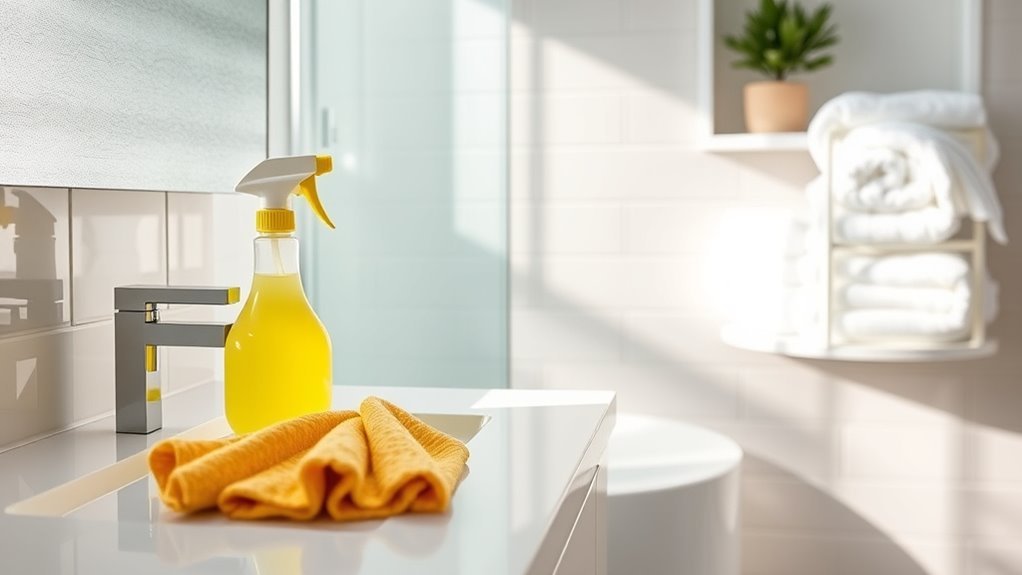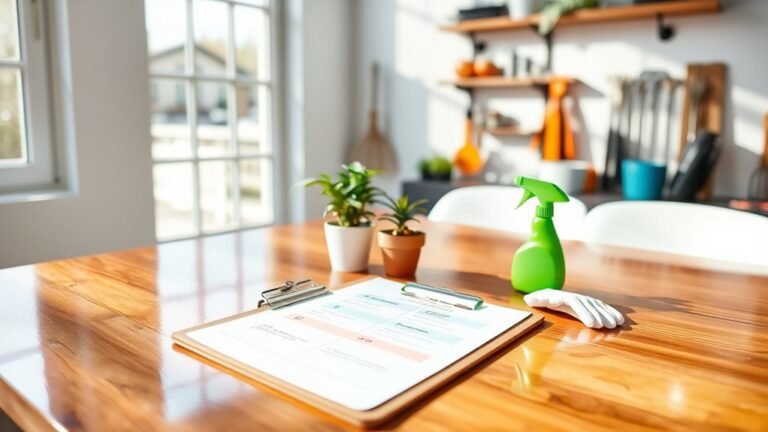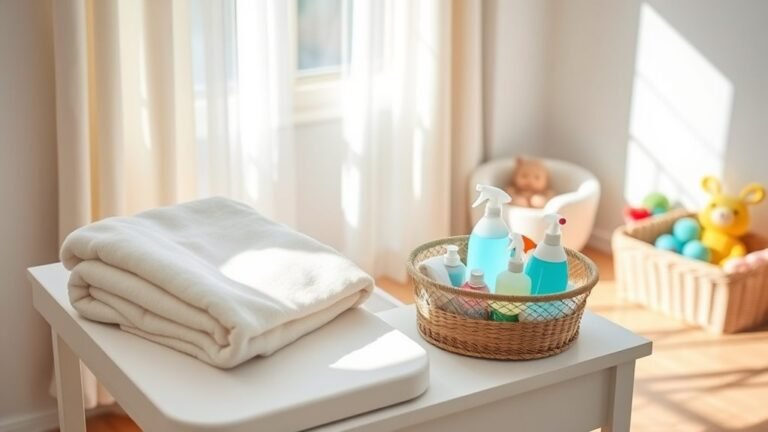Cleaning Checklist for Bathroom Businesses
You’ll want a detailed cleaning checklist that covers daily tasks like wiping sinks, mopping floors, and restocking essentials. Weekly, focus on deep cleaning grout, vents, and mirrors. Don’t forget sanitizing high-touch areas with EPA-approved products, managing waste with labeled bins, and guaranteeing proper ventilation to prevent mold. Keep supplies organized and document every cleaning to track performance. Plus, training your staff on protocols guarantees consistent hygiene standards. There’s more on scheduling, mold prevention, and staff training that can help you stay ahead.
Daily Cleaning Tasks for Bathroom Facilities
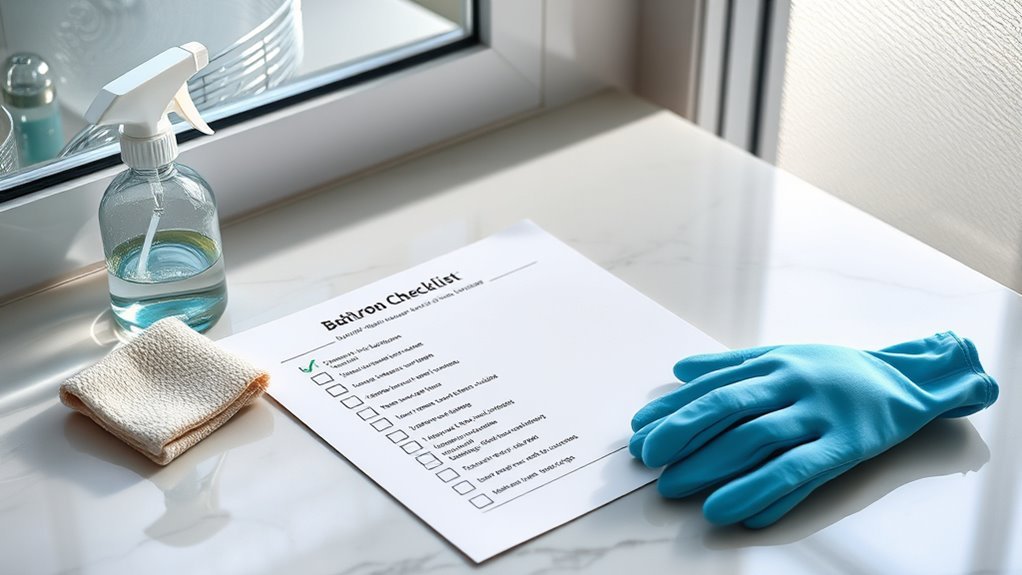
To keep your bathroom facilities fresh and hygienic every day, focus on five essential cleaning tasks. Start by wiping down sinks and counters with eco friendly products to reduce chemical exposure while maintaining cleanliness. Empty trash bins promptly to prevent odors and overflow. Sanitize high-touch areas like door handles, faucets, and flush levers to minimize germ spread. Mop floors using environmentally safe solutions, ensuring no residue remains. Finally, restock supplies such as soap and paper towels to keep users comfortable. Establish clear cleaning schedules, assigning specific tasks to times and personnel, so nothing gets overlooked. By sticking to this practical routine, you’ll maintain a clean, inviting bathroom that supports your freedom from constant worry about hygiene and upkeep.
Weekly Deep Cleaning Procedures
Every week, you’ll need to perform a thorough deep cleaning to maintain the highest standards of bathroom hygiene. Start by selecting effective cleaning products designed for tough stains, mineral deposits, and soap scum. Focus on scrubbing grout lines, baseboards, and behind fixtures where dirt accumulates unnoticed. Pay close attention to drains and vents, ensuring they’re free of buildup. Use brushes and microfiber cloths to reach tight spaces, maximizing cleanliness without damaging surfaces. Don’t forget to clean mirrors and glass with streak-free products for a polished look. Organize your process room by room, so no area is skipped. This routine deep cleaning not only prevents grime but also extends the life of your fixtures, giving you the freedom to focus on other business priorities without worry.
Sanitizing High-Touch Surfaces Effectively
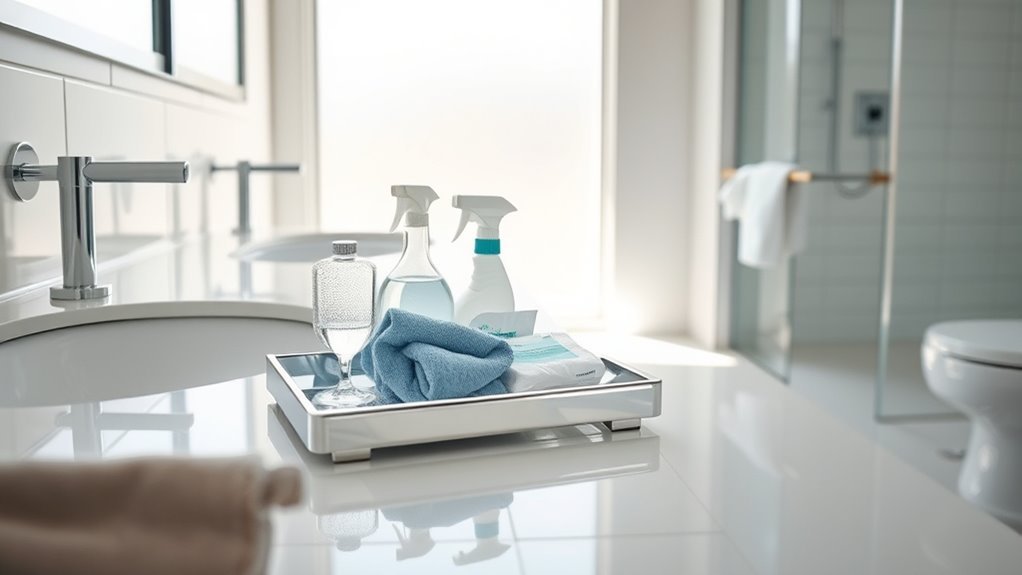
Focus on sanitizing key high-touch areas like faucet handles, light switches, and door knobs to reduce germs effectively. Use disinfectants that are EPA-approved and follow the recommended contact time for best results. Make sure to wear gloves and ventilate the space while cleaning to protect yourself.
Key High-Touch Areas
High-touch surfaces in your bathroom, like faucet handles, light switches, and door knobs, require thorough sanitizing to prevent the spread of germs. Identifying these key areas and setting an appropriate cleaning frequency guarantees your bathroom stays hygienic and welcoming. Focus on spots people touch often, as neglecting them increases contamination risk.
| High-Touch Area | Cleaning Frequency | Notes |
|---|---|---|
| Faucet Handles | Multiple times/day | Use disinfectant wipes |
| Door Knobs | Multiple times/day | Pay attention to both sides |
| Light Switches | Daily | Often overlooked but essential |
Best Disinfecting Practices
Keeping key bathroom surfaces clean is only part of the process; knowing how to disinfect them properly guarantees germs are effectively eliminated. Start by selecting appropriate disinfectant types—look for EPA-approved products suited for bathroom use, such as quaternary ammonium compounds or bleach solutions. Follow manufacturer instructions closely, paying attention to contact time to ascertain maximum effectiveness. Establish clear cleaning schedules targeting high-touch areas like door handles, faucets, and toilet flush levers, ideally disinfecting multiple times daily. Use microfiber cloths for application to avoid cross-contamination and replace them regularly. Don’t forget to wear gloves and ventilate the space well during disinfection. By combining the right disinfectant types with a structured cleaning schedule, you’ll maintain a hygienic environment that supports both your business’s reputation and your customers’ peace of mind.
Restocking and Organizing Supplies
You’ll want to keep a clear inventory of your bathroom supplies to know exactly when it’s time to restock. Organize items by category and frequency of use, placing essentials within easy reach and less-used products in labeled bins. Optimizing your storage space not only saves time but also keeps your bathroom tidy and functional.
Inventory Management Techniques
Although managing bathroom supplies might seem straightforward, maintaining an efficient inventory system requires careful attention to restocking and organization. You’ll want to establish regular supply tracking to monitor usage rates and identify when items need replenishing. Implementing scheduled inventory audits helps prevent shortages and overstock, giving you control over your resources. Use simple, consistent labeling to keep supplies easy to locate, making restocking smoother. Record each restock and audit clearly—this data guides your purchasing decisions and avoids waste. By staying proactive, you free yourself from last-minute scrambles and guarantee your bathroom always meets customer expectations. Streamlining these inventory management techniques ultimately gives you the freedom to focus on running your business rather than chasing supplies.
Storage Optimization Strategies
When optimizing storage for bathroom supplies, it’s essential to design a system that balances accessibility with space efficiency. Start by evaluating your current storage areas to maximize space utilization—think vertical shelving or clear bins for quick visibility. Use labeled containers and adjustable racks as practical storage solutions to keep items organized and easy to restock. Group supplies by frequency of use; place daily essentials within arm’s reach, while less-used items can occupy higher or less accessible spots. Implement a first-in, first-out restocking method to prevent clutter and expired products. By maintaining this organized approach, you’ll free up time and reduce stress, giving you the freedom to focus on other tasks. Efficient storage optimization truly transforms your workspace into a streamlined, functional environment.
Proper Waste Disposal and Management
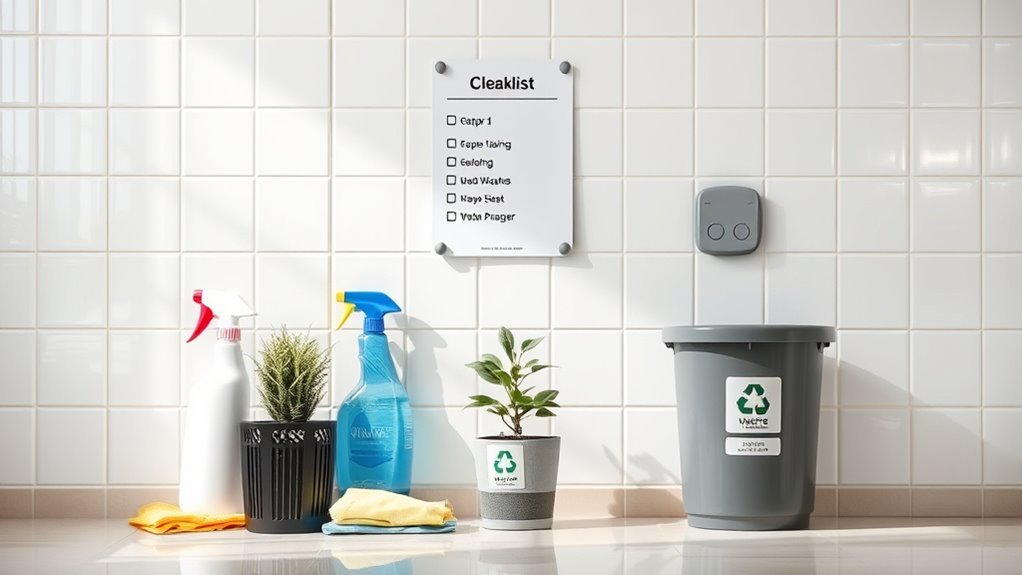
Since bathrooms generate various types of waste, managing disposal properly is crucial to maintain hygiene and prevent odors. Start by implementing clear waste segregation: separate recyclables like paper and plastics from general waste. Use labeled bins to make it easy for staff and customers to participate. Partner with local recycling programs to guarantee these materials are processed responsibly, reducing environmental impact. Regularly empty bins to avoid overflow and sanitize them to keep odors at bay. Also, consider using sealed, odor-resistant containers for sanitary waste to maintain a clean atmosphere. By organizing waste disposal thoughtfully and following these practical steps, you’ll promote a cleaner, fresher bathroom environment that aligns with your goal of maintaining freedom from mess and discomfort.
Cleaning and Maintaining Fixtures and Fittings
Keeping fixtures and fittings clean and well-maintained plays an essential role in guaranteeing your bathroom stays hygienic and functional. Start by regularly wiping down faucets, handles, and showerheads with non-abrasive cleaners to prevent buildup and water spots. For effective fixture care, focus on polishing metal surfaces and tightening loose screws or bolts to avoid leaks and damage. When it comes to fitting maintenance, inspect seals and joints frequently, replacing worn-out washers or gaskets promptly to maintain water efficiency and prevent drips. Don’t forget to clean drains and aerators to guarantee smooth water flow. By following a consistent schedule and using the right tools, you’ll keep your bathroom’s fixtures and fittings in top shape, giving you the freedom to focus on other priorities without worrying about unexpected repairs.
Addressing Mold and Mildew Prevention
To prevent mold and mildew, you’ll want to focus on effective ventilation by using exhaust fans or opening windows during and after showers. Regularly treating surfaces with mold-resistant cleaners keeps growth at bay before it starts. Consistent attention to these steps will help maintain a healthy, fresh bathroom environment.
Effective Ventilation Strategies
Although bathrooms are designed to handle moisture, inadequate ventilation can quickly lead to mold and mildew buildup. To maintain ideal airflow management and humidity control, you need effective ventilation strategies that keep your space fresh and dry. Here’s what you can do:
- Install and Maintain Exhaust Fans: Confirm fans are powerful enough to remove moisture and clean them regularly to maintain efficiency.
- Utilize Natural Ventilation: Open windows or vents when possible to promote cross-ventilation, reducing dampness.
- Incorporate Humidity Sensors: Automated systems can activate ventilation when humidity rises, preventing excessive moisture accumulation.
Regular Surface Treatment
Regularly treating bathroom surfaces is essential if you want to prevent mold and mildew from taking hold. The surface treatment benefits include not only inhibiting microbial growth but also extending the lifespan of your fixtures. To maximize these benefits, focus on cleaning product selection—choose antifungal agents that suit the material and avoid harsh chemicals that could cause damage.
| Surface Type | Recommended Treatment | Frequency |
|---|---|---|
| Tile & Grout | Antifungal cleaner & sealant | Weekly |
| Glass & Mirrors | Vinegar solution | Twice a week |
| Countertops | pH-neutral disinfectant | Daily |
Ensuring Adequate Ventilation and Air Quality
Proper ventilation plays an essential role in maintaining a fresh and healthy bathroom environment. To guarantee ideal air quality, you need to focus on your ventilation systems and their upkeep. Here’s how to keep it effective:
- Inspect and clean exhaust fans regularly to prevent dust buildup, which can reduce airflow and trap odors.
- Confirm that ventilation systems are correctly sized for your bathroom’s square footage, guaranteeing air circulates freely and moisture doesn’t linger.
- Incorporate natural ventilation when possible by opening windows or installing vents that encourage airflow without sacrificing privacy.
Scheduling and Documenting Cleaning Activities
When you create a clear schedule and document each cleaning task, you’ll assure nothing is overlooked and maintenance stays consistent. Start by designing cleaning schedules that specify daily, weekly, and monthly duties, assigning responsible team members to each. Use straightforward documentation methods like checklists or digital logs, which track completion times and any issues encountered. This organized approach not only keeps your bathroom spotless but also empowers you to monitor performance and identify areas needing improvement. Consistent record-keeping frees you from micromanaging, giving you time to focus on other priorities. By adopting precise cleaning schedules and reliable documentation methods, you assure your bathroom business operates smoothly, meets hygiene standards, and maintains a welcoming environment without constant oversight.
Training Staff on Bathroom Cleaning Protocols
Documenting cleaning tasks clearly sets the foundation for effective staff training on bathroom cleaning protocols. To guarantee staff engagement and protocol adherence, you need a structured approach. First, provide thorough orientation covering cleaning products, equipment use, and safety measures. Second, demonstrate step-by-step procedures, emphasizing critical areas like toilets and sinks to maintain hygiene standards. Third, implement regular assessments and feedback sessions to reinforce correct practices and address any gaps. By following this plan, you empower your team with the knowledge and confidence to clean efficiently while maintaining freedom in their workflow. Consistent training builds accountability and ensures everyone understands the importance of each task, ultimately safeguarding your business’s reputation and cleanliness standards.
Frequently Asked Questions
What Eco-Friendly Cleaning Products Are Safe for Bathroom Businesses?
Think of eco-friendly cleaning products as gentle rain nurturing your bathroom’s surfaces without harm. You’ll want biodegradable cleaners like those with plant-based surfactants—they break down naturally, sparing the environment. Pair these with natural disinfectants such as vinegar or tea tree oil to keep germs at bay without harsh chemicals. Staying organized means labeling each product clearly and storing them safely, giving you freedom to maintain cleanliness responsibly and efficiently.
How Often Should Plumbing Inspections Be Conducted in Bathroom Facilities?
You should follow plumbing frequency guidelines by scheduling inspections at least twice a year to keep everything running smoothly. Regular plumbing inspections help catch leaks, blockages, or wear before they cause costly problems. Stick to these inspection guidelines to maintain efficiency and avoid unexpected downtime. If your facility experiences heavy use, consider quarterly checks. Staying organized with timely plumbing inspections gives you the freedom to focus on other priorities without worry.
What Are the Best Practices for Handling Customer Complaints About Bathroom Cleanliness?
You’d think handling customer complaints about bathroom cleanliness requires superhero patience! Start by listening carefully to customer feedback without interrupting. Acknowledge the issue quickly to show you care, then follow a clear complaint resolution process: investigate, act promptly, and update the customer. Keep detailed records to spot patterns and prevent repeats. Staying organized and transparent not only solves problems but also gives customers the freedom to trust your commitment to a spotless, welcoming space.
Can Automated Cleaning Robots Be Used Effectively in Commercial Bathrooms?
You can definitely use automated cleaning robots effectively in commercial bathrooms, especially with advances in cleaning technology. Their robot efficiency helps maintain consistent cleanliness without constant supervision, freeing you from manual tasks. However, you’ll want to combine robots with human oversight to handle tricky spots and guarantee thorough sanitation. By integrating these tools, you get practical, organized cleaning that saves time and gives you more freedom to focus on other priorities.
How Do Seasonal Changes Affect Bathroom Maintenance Schedules?
Like clockwork, the seasons change, and so should your bathroom maintenance. You’ll need seasonal supplies tailored to temperature fluctuations—think heavier-duty deodorizers in summer’s heat and antifreeze measures in winter’s chill. Adjust your cleaning frequency and inventory accordingly, ensuring no surprise slips disrupt your routine. By staying organized and proactive, you’ll maintain a fresh, reliable space that frees you from unexpected issues, letting you focus on what truly matters.
